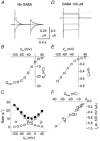The relation between charge movement and transport-associated currents in the rat GABA cotransporter rGAT1
- PMID: 12482883
- PMCID: PMC2290732
- DOI: 10.1113/jphysiol.2002.026823
The relation between charge movement and transport-associated currents in the rat GABA cotransporter rGAT1
Abstract
Most cotransporters characteristically display two main kinds of electrical activity: in the absence of organic substrate, transient presteady-state currents (I(pre)) are generated by charge relocation during voltage steps; in the presence of substrate, sustained, transport-associated currents (I(tr)) are recorded. Quantitative comparison of these two currents, in Xenopus oocytes expressing the neural GABA cotransporter rGAT1, revealed several unforeseen consistencies between I(pre) and I(tr), in terms of magnitude and kinetic parameters. The decay rate constant (r) of I(pre) and the quantity of charge displaced to an inner position in the transporter (Q(in)(0)) depended on voltage and ionic conditions. Saturating GABA concentrations, applied under the same conditions, suppressed I(pre) (i.e. Q(in)( infinity ) = 0) and produced a transport-associated current with amplitude I(tr) = Q(in)(0)r. At non-saturating levels of GABA, changes of I(tr) were compensated by corresponding variations in Q(in), such that I(pre) and I(tr) complemented each other, according to the relation: I(tr) = (Q(in)(0) - Q(in)) r. Complementarity of magnitude, superimposable kinetic properties and equal dependence on voltage and [Na(+)](o) point to the uniqueness of the charge carrier for both processes, suggesting that transport and charge migration arise from the same molecular mechanism. The observed experimental relations were correctly predicted by a simple three-state kinetic model, in which GABA binding takes place after charge binding and inward migration have occurred. The model also predicts the observed voltage dependence of the apparent affinity of the transporter for GABA, and suggests a voltage-independent GABA binding rate with a value around 0.64 microM(-1) s(-1).
Figures








Similar articles
-
Cl- affects the function of the GABA cotransporter rGAT1 but preserves the mutal relationship between transient and transport currents.Cell Mol Life Sci. 2003 Mar;60(3):550-6. doi: 10.1007/s000180300046. Cell Mol Life Sci. 2003. PMID: 12737314 Free PMC article.
-
Temperature effects on the presteady-state and transport-associated currents of GABA cotransporter rGAT1.FEBS Lett. 2002 Feb 13;512(1-3):303-7. doi: 10.1016/s0014-5793(02)02271-8. FEBS Lett. 2002. PMID: 11852100
-
Mutation K448E in the external loop 5 of rat GABA transporter rGAT1 induces pH sensitivity and alters substrate interactions.J Physiol. 2001 Oct 15;536(Pt 2):479-94. doi: 10.1111/j.1469-7793.2001.0479c.xd. J Physiol. 2001. PMID: 11600683 Free PMC article.
-
Sorting of GABA transporter proteins in polarized cells.Neurochem Int. 1996 Oct;29(4):357-60. doi: 10.1016/0197-0186(95)00159-x. Neurochem Int. 1996. PMID: 8939443 Review. No abstract available.
-
GABA transporter function in the horizontal cells of the skate.Prog Brain Res. 2001;131:267-75. doi: 10.1016/s0079-6123(01)31022-1. Prog Brain Res. 2001. PMID: 11420946 Review. No abstract available.
Cited by
-
An inverse relationship links temperature and substrate apparent affinity in the ion-coupled cotransporters rGAT1 and KAAT1.Int J Mol Sci. 2012 Nov 22;13(12):15565-74. doi: 10.3390/ijms131215565. Int J Mol Sci. 2012. PMID: 23443081 Free PMC article.
-
Transient currents in the glycine cotransporter GlyT1 reveal different steps in transport mechanism.J Mol Neurosci. 2010 Jun;41(2):243-51. doi: 10.1007/s12031-009-9281-9. Epub 2009 Aug 27. J Mol Neurosci. 2010. PMID: 19711201
-
Functional characterization of Atlantic salmon (Salmo salar L.) PepT2 transporters.J Physiol. 2022 May;600(10):2377-2400. doi: 10.1113/JP282781. Epub 2022 Apr 28. J Physiol. 2022. PMID: 35413133 Free PMC article.
-
Turnover rate of the gamma-aminobutyric acid transporter GAT1.J Membr Biol. 2007 Dec;220(1-3):33-51. doi: 10.1007/s00232-007-9073-5. Epub 2007 Nov 9. J Membr Biol. 2007. PMID: 17994179 Free PMC article.
-
Effect of substrate on the pre-steady-state kinetics of the Na(+)/glucose cotransporter.Biophys J. 2007 Jan 15;92(2):461-72. doi: 10.1529/biophysj.106.092296. Epub 2006 Oct 27. Biophys J. 2007. PMID: 17071656 Free PMC article.
References
-
- Binda F, Bossi E, Giovannardi S, Forlani G, Peres A. Temperature effects on the presteady-state and transport-associated currents of GABA cotransporter rGAT1. FEBS Letters. 2002;512:303–307. - PubMed
Publication types
MeSH terms
Substances
LinkOut - more resources
Full Text Sources

